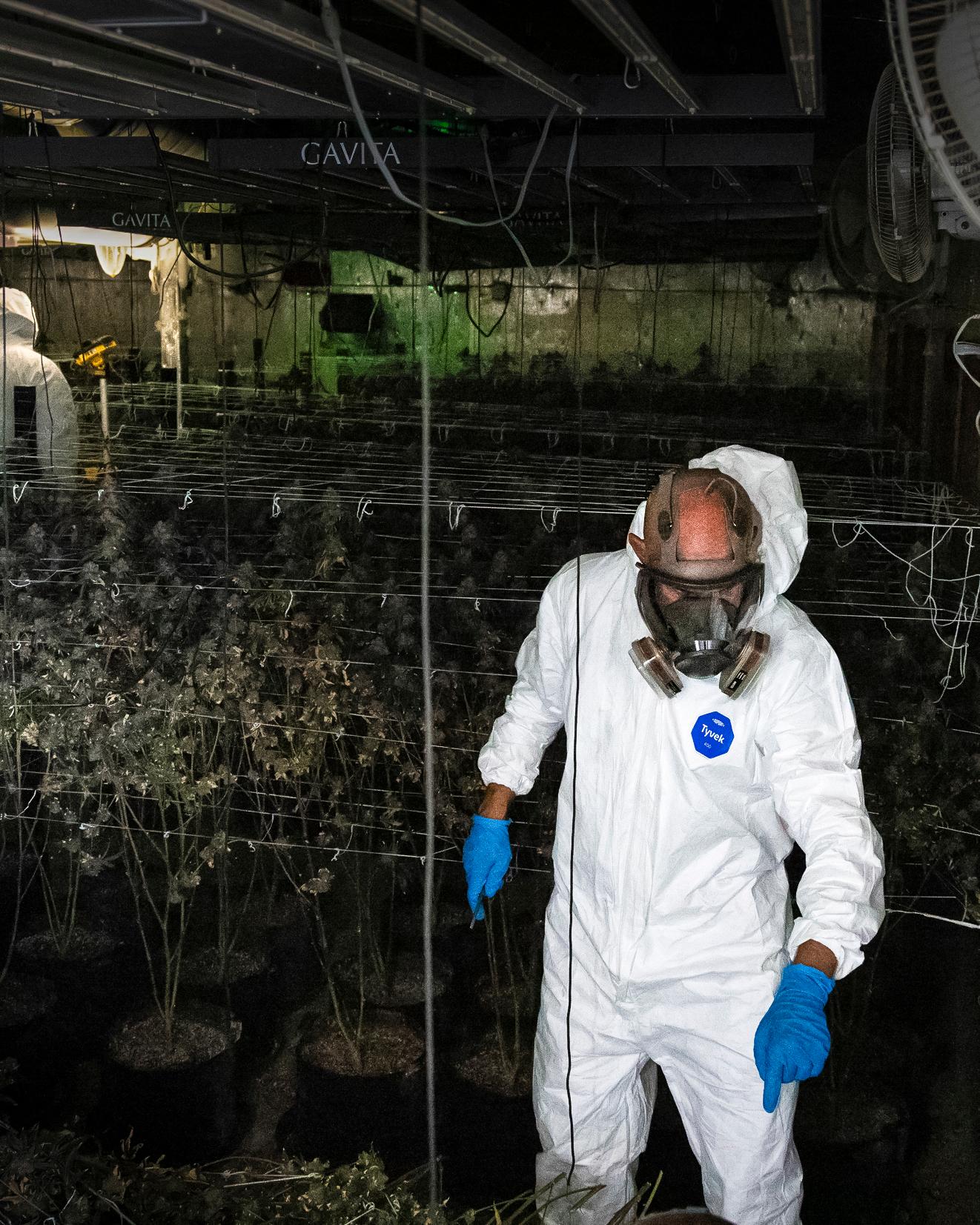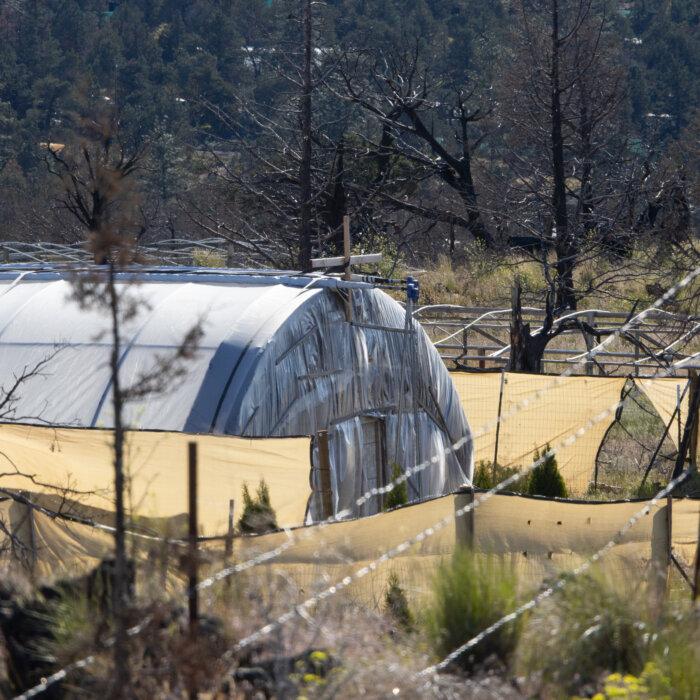LOS ANGELES—On a recent summer morning, a caravan of unmarked state police vehicles and white hazmat trucks crept past strip malls and wide intersections, making its way toward a pair of modest homes in a remote suburb north of Los Angeles.
A command came from the officers in the front of the black-and-white vehicles: “Seat belts off—in case we start taking fire.”

But there was no shootout. Just a tense half-hour as a phalanx of two dozen state police officers—agents from the Department of Cannabis Control (DCC)—kept snipers trained on the house, waiting for the second of two suspects to emerge.
When she finally did, petite and barefoot in a black dress, the effect was mercifully anticlimactic.
Illegal cannabis cultivation operations, or “grows,” are a multibillion-dollar-per-year industry in California, dominated by a mix of transnational criminal organizations that authorities believe are symbiotic, if adversarial.
When agents serve a warrant, they often find human trafficking victims, automatic weapons, booby traps, and, increasingly, banned toxic pesticides smuggled from China.
This particular raid, in Lancaster, netted about 1,020 plants—a modest haul compared with the herculean grows that have become common across California’s booming black market.
But such mild suburban tableaus belie a sleeping, sinister threat.
“What we have right now is organized criminal enterprises literally destroying the city building by building as they modify them for illegal cultivation,” Mike Katz, a Lancaster code enforcement officer who heads the city’s cannabis unit, told The Epoch Times.
‘Super Toxic’
Buildings contaminated by illegal grows are dangerous because the harsh pesticides that growers use permeate every surface—ceilings, walls, floors, vents, and drywall.Toxic black mold blooms in the 75 percent humidity needed to grow marijuana. The massive amounts of water and electricity required to sustain an operation can result in structural damage to vents and sunken floors, overloaded transformers, and corroded wiring just itching for a fire.
Katz, whom the city’s chief of police refers to as the department’s “Swiss Army knife,” has been a firefighter, reserve police officer, and now, an unarmed code enforcement official. He approaches the job with a certain zeal, devouring scientific studies and how-to books on cultivation and generally making it his mission to stop grow houses from slipping through the cracks.
Owners can often get away with making cosmetic fixes—“candy coating,” as one inspector put it—if local governments don’t intervene before they start concealing the damage.


The injustice of it rankles Katz. He said he imagines families struggling to buy a home, and their toddlers probing surfaces tainted with insecticides—potent carcinogens, endocrine disruptors, nerve agents, and others no one even knows how to identify.
“They are super toxic, but very effective,” he said. “One we just learned of last week has a 14-year half-life. We did a search warrant back in January and didn’t get test results until this week. I’m having to tell all the detectives and everyone involved that we were exposed to these chemicals.”
Low-cost housing also attracts sophisticated criminal enterprises looking for ways to launder money and turn a profit. Often, illegal growers can do that after just one harvest. Typically, an operation can turn four to six harvests per year.
Wholesale value for the plants seized in the modest raid we accompanied—they were days away from a second harvest—is more than $540,000.
To avoid detection and stay a step ahead of authorities, growers are continually adapting.
“There are probably a lot more growing indoors that we don’t know about,” Jennifer Morris, a code enforcement officer with Riverside County and former head of its cannabis unit, told The Epoch Times. “But they’re pretty good at keeping themselves looking very nondescript.”
From the outside, the houses look normal, and it usually takes a fire, robbery, or neighbors reporting electrical theft to tip off law or code enforcement, according to Morris. Growers also build walls to conceal grow rooms, and they sometimes install a resident worker or own a dog to give the appearance of normality.
Because the entire industry is clandestine, no one can accurately estimate the extent of the problem. Many communities might not even be aware it’s happening.
“I’ve talked to cities where they say, ‘We don’t have a problem,’” said David Welch, an attorney who contracts as a special counsel with cities in Los Angeles County that want “a more aggressive” approach to narcotics enforcement. “Then law enforcement will hit a grow in that city.”
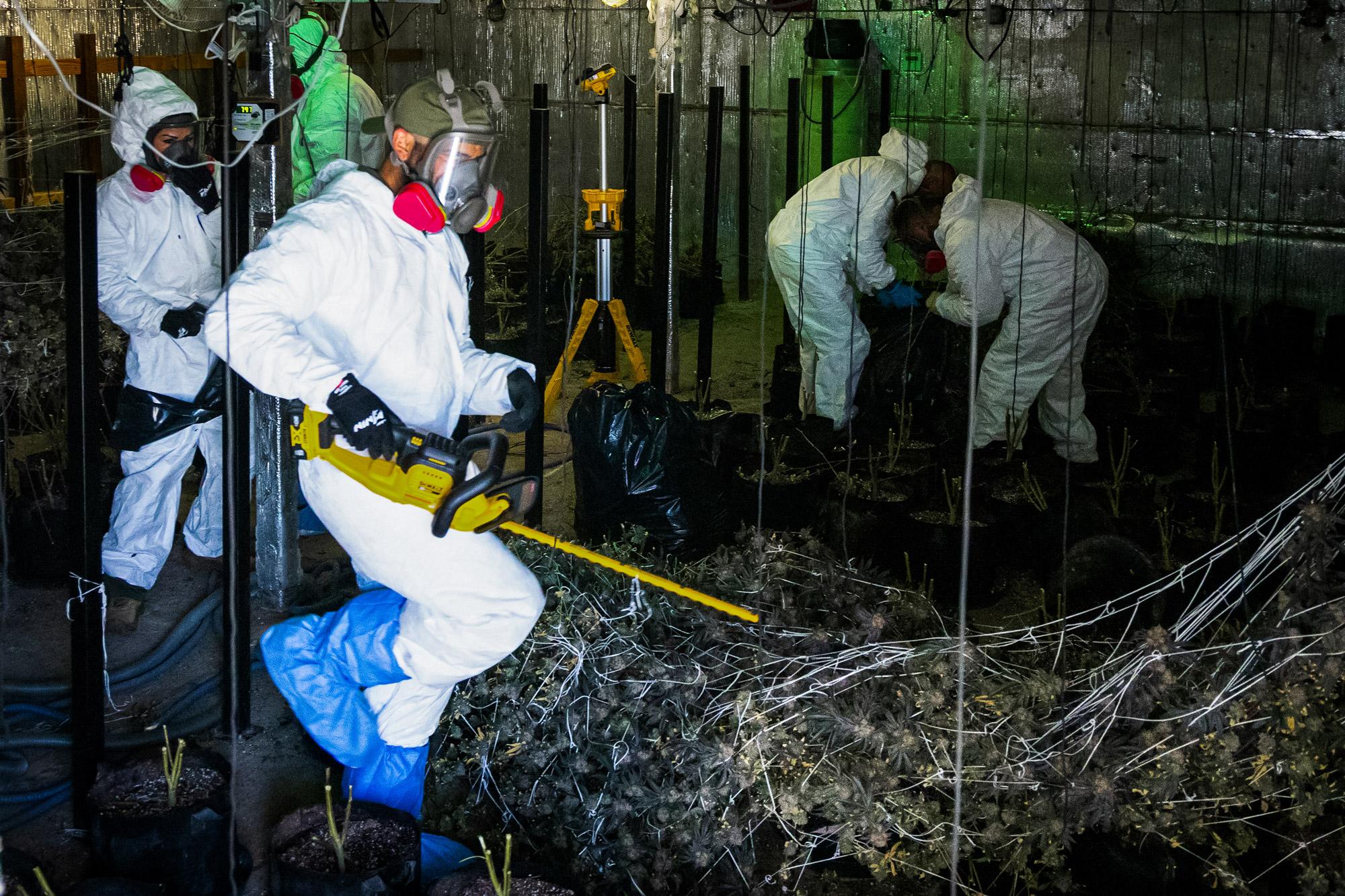
Where there is one, there are likely more. But perpetrators are opportunistic, itinerant.
“We have seen the same owners of properties in different counties that have had illegal cultivation on them,” Morris said.
Wilson Linares, who leads the Department of Cannabis Control’s Los Angeles County law enforcement unit, said it’s hard to pinpoint which players are tied to which territories.
“They’re just everywhere,“ he said. ”It doesn’t really stay in that area; they just go wherever they can master operations.”
Growers, he said, “do a good job of layering their operation.”
“I don’t think they even know they’re working for the same organization sometimes,” Linares said.
That makes it difficult to go after the few bigger fish, to which, some insiders say, all these operations are ultimately “funneling up.”
Those caught at the grows are inevitably low-level employees, if not forced labor, and are typically interviewed and released. Illegal cultivation—anything more than six plants per person, whether it’s 10 or 10,000—is a misdemeanor in California.
“Sometimes our investigations do a good job at digging to make sure we’re eradicating the problem,” Linares said. “But sometimes they cut losses and move on and go somewhere else. We have to follow and chase them. It takes a lot of effort and time to conduct these investigations.”
Like meth houses of decades past, there are residential grows too damaged to flip.
But it’s the moderate ones, the ones that are at risk of selling at a discount to families, that Katz said keep him up at night.
While they can’t prevent the sale, or in many cases, habitation, building inspectors and code enforcement officers use “red tagging” and other methods to compel compliance—such as creating liens to cloud the title or disconnecting utilities. And in some cases, those costs and headaches transfer to new owners.
California law gives local government broad authority to abate “public nuisances”—which include dangerous and contaminated buildings, according to Katz. But enforcing compliance can often depend on a municipality’s ability to pay for things such as civil lawsuits.
If public safety officials don’t discover a grow before property owners start hiding the damage, it’s often too late.
“There is no roadmap,” Katz said. “These sociopaths are buying and selling these houses.”
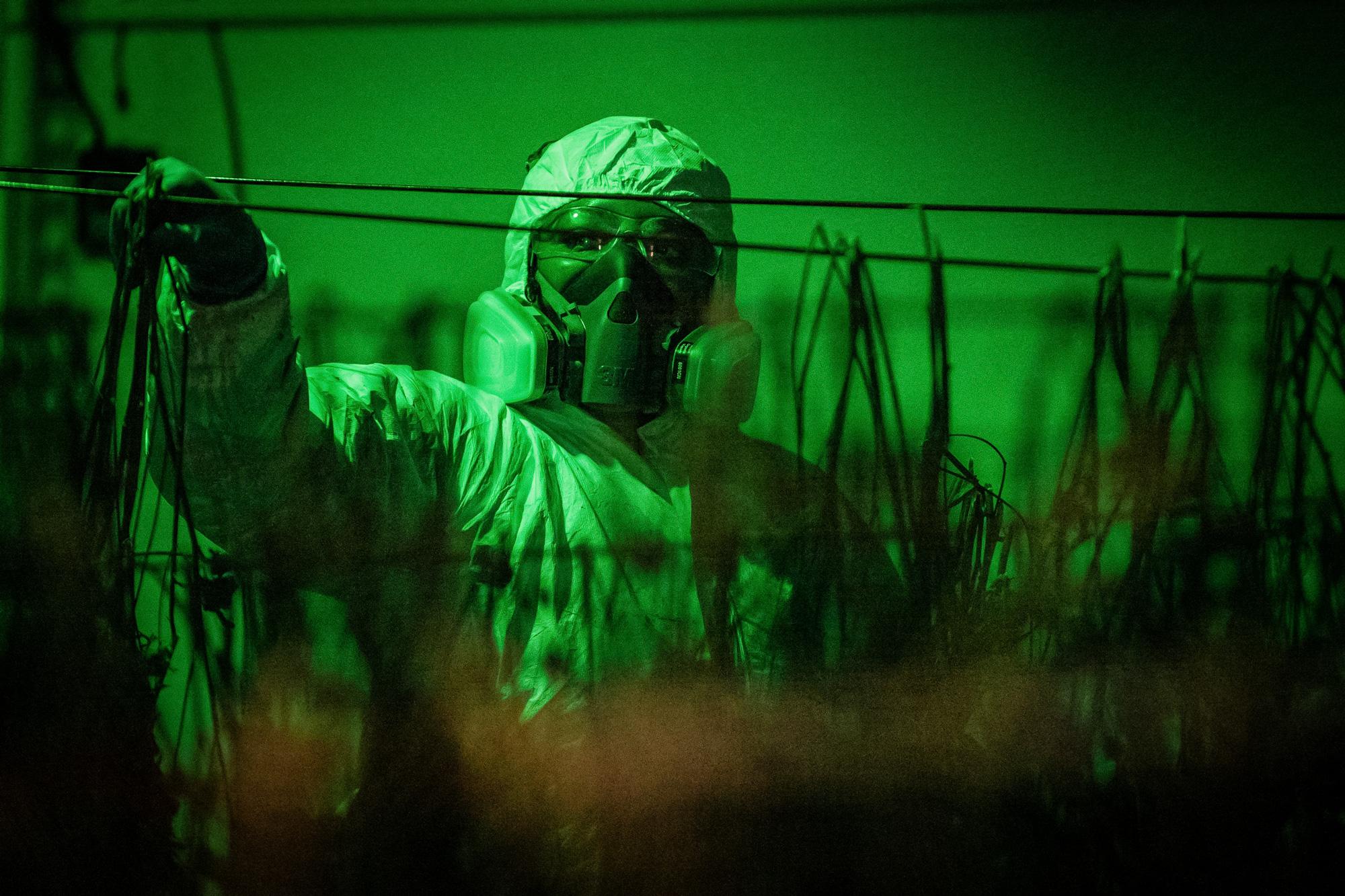
‘I Didn’t Know Anything’
There were signs: two dozen large bags of what Virginia Aceres thought was ordinary grass fertilizer and canisters of chemicals bearing designs of spiders and worms that the previous owner left behind. He offered to pay her $500 to get rid of them.In two months, she received a $10,000 electricity bill.
Aceres said she moved from Los Angeles to the Antelope Valley because she didn’t want her kids hanging out with people who use drugs. She nabbed a five-bedroom house for $535,000, $15,000 below asking.
“It’s super big—we thought, ‘Oh wow, this is perfect.’”
But she found out after moving in that it had been used by the previous owners to grow weed.
“Every afternoon, the upstairs smells of marijuana, and it gives me a raging headache,” Aceres told The Epoch Times.
When a city inspector came by and pointed out a meter wired to steal electricity and stains on the bathroom ceilings from burned chemicals, she said, “Now I understand.”
The five bedrooms were originally three, she discovered; the previous owner had added two, and it was up to her to register the additions with the city.
When property owners obtain permits to modify buildings but don’t follow up to call for a final inspection of the work, this can tip off code enforcement and form part of the basis for a warrant. So too can electrical fires or electricity theft.
But Aceres said she bought her house without any compliance obligations that would arise from pre-sale code enforcement; inspectors came after she moved in and pointed out the damage.
The circuit breakers at her house are constantly blowing, especially if electronics are running at the same time, and electricians tell her she has to completely redo the wiring.
“My daughter relies on a machine to help her breathe,” Aceres said, referring to a nebulizer that delivers oxygen and liquid steroids. “We had to buy a generator. She’s 9; she can’t ride a bike, can’t walk more than 20 minutes, can’t run. At night she has panic attacks, she comes to my door in pain, she can’t breathe, so I connect the machine and give her medicine.”
A neighbor warned her that the previous owner had installed multiple massive air conditioners and that there were fires. People cruise by the house. Someone showed up looking to collect on a debt. The IRS, the police, and city inspectors have all visited.
“For all this, I’d like to move—because they’re going to confuse us, and they’re going to think that we sell drugs or have something to do with all that. But we haven’t been able to sell the house because of all these problems,” she said. “If a buyer asks questions, we’re obligated to tell them the truth.”
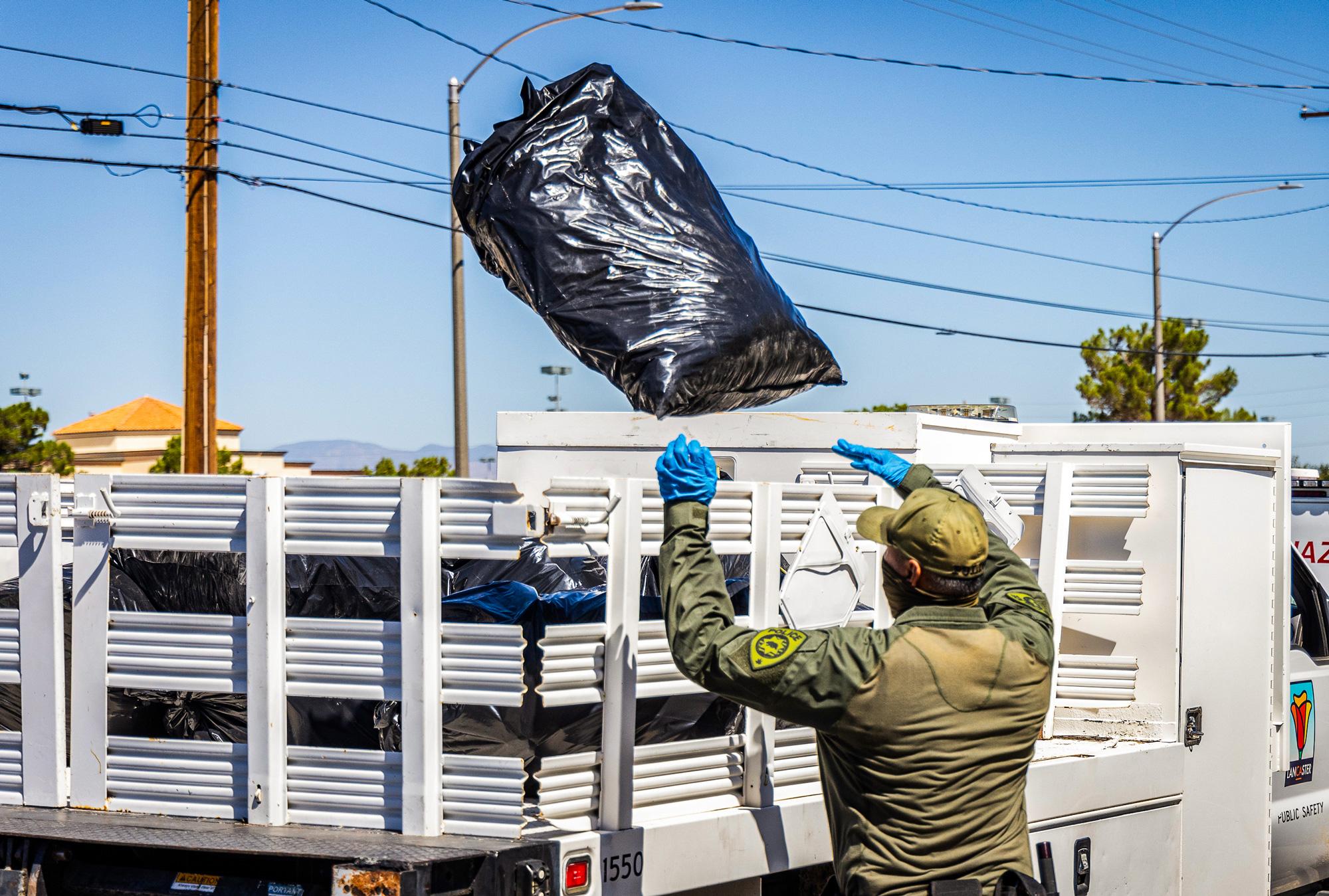
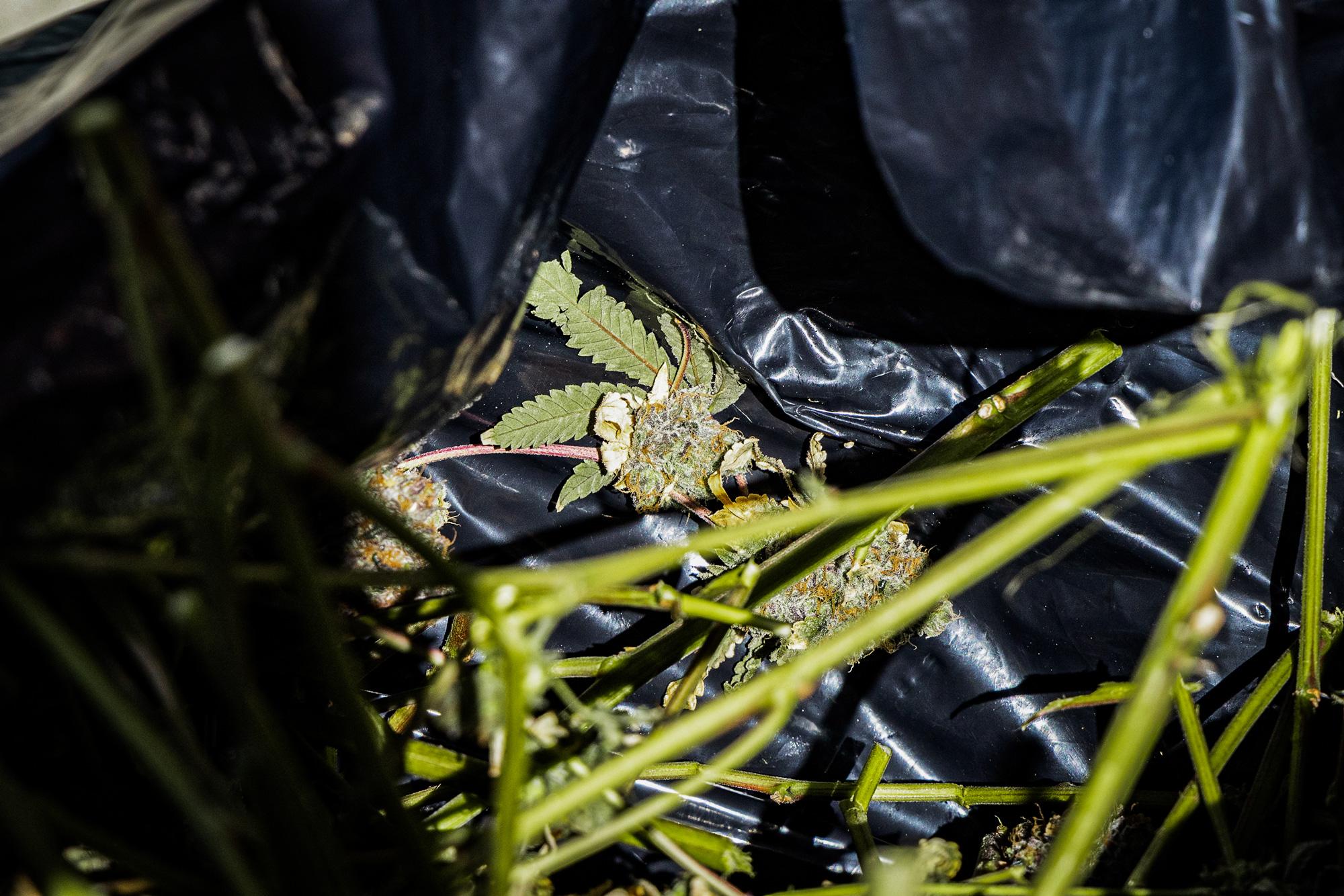
Banned Pesticides
Labor and sex trafficking, animal abuse, gun violence, and rampant environmental crimes have long been associated with illegal marijuana cultivation.But the influx of banned toxic insecticides in California’s illicit operations is relatively novel, according to those on the front lines.
“About a year ago, we started seeing these banned pesticides—they’ve made their way into most of the cultivation sites,” said Jeremiah LaRue, sheriff of Siskiyou County.
While operations have moved from federal lands to private property in recent years, LaRue said these days it’s a mix of outdoor grows, “hoop houses,” and some converted residential homes.
Linares said he noticed an uptick in pesticides as some producers transitioned from outdoor to indoor.
“They’re easier to operate in that they can control the environment a lot better. So that’s why at least in the Los Angeles County area you see quite a few indoor grows,” he said, pointing to the Antelope Valley as a primary SoCal hotspot, along with the San Fernando Valley and Frazier Park in Kern County.
It may seem counterintuitive that indoor operations are increasingly relying on contraband pesticides, but the lack of natural predators inside means spider mites, aphids, mildew, and black rot or fungus can easily take hold, according to Josh Wurzer, CEO and co-founder of SC Labs, a cannabis testing and research lab based in Santa Cruz, California, with outlets in Colorado, Arizona, Oregon, and Michigan.
“Once you get a single fungus spore or any tiny spider mite into a grow and it starts to proliferate, they take root and it takes off,“ he said. ”There are no birds to eat them or natural controls to keep pests in check like there are outdoors.”
Morris said she has observed a lot of indoor grows using fumigated miticides.

“They tend to have a problem with spider mites, and I think some of the problem is someone tending several house grows, they get mites on them and take them to the next location,” she said.
In the regulated market, growers have adopted organic solutions—such as neem oil, predatory insects, and sterile environments, Wurzer said. But on the black market, where there is no testing and no regulation, the point is to make money as fast as possible.
“If no one is checking, if consumers won’t know the difference, people will do what is easiest,” Wurzer said. “And the easiest solution is to spray all kinds of pesticides so there are no problems with pests and you get the highest yield and make as much money as possible.”
The California Department of Pesticide Regulation publishes a pocket guide for law and code enforcement officers, listing more than two dozen insecticides, fungicides, miticides, rodenticides, and plant growth regulators to look out for in mitigation operations. Several are banned in the United States.
‘No One Is Going to Find It’
At recent raids, Katz’s team found endrine, a highly toxic pesticide with neurological, developmental, and reproductive effects that was discontinued in the United States in 1986 and has been shown to persist in soil for 14 years or more. They also found endosulfan sulfate, a similarly toxic pesticide known to be an endocrine disruptor, that was phased out in the United States by 2010 and globally banned under the 2011 Stockholm Convention.“All kinds of chemicals are being found. The ones from China, they’re not even in any chemical library,” Katz said, noting that they’re having to send samples to an “extremely expensive” lab in Sacramento.
“The EPA got involved. We’ve found all kinds of nerve agent pesticides, and they’re not listed in any of these libraries for the machines that read this stuff.”
When it comes to testing for pesticides on the regulated market, Wurzer said a proper lab can find any chemical eventually—if they’re looking for it and they know it exists.
“But we’re not as good at finding things we’re not looking for,“ Wurzer said. ”If someone develops a new pesticide, until people realize it’s being used, no one is going to be looking for it, so no one is going to find it.”
That problem extends to products consumers buy in state-regulated dispensaries. While Wurzer said that less than 3 percent of regulated cannabis samples his lab tests contain pesticides, growers are getting “really creative,” using compounds they know won’t show up in panels in order to circumvent regulation.
“A lot of these line up with what we find in illegal grows—pesticides with Chinese origin,” he said.
Wurzer said that after a recent investigation found “alarming” levels of toxic pesticides in regulated products, he’s begun offering an expanded testing panel that includes some of these known black-market pesticides. But there are plenty of disreputable labs, he said, that will produce results their clients want to see.

On illegal grow sites, some pesticides look like wood chips, burned in halved soda cans as a fumigant; others come in bottles that are mixed and repurposed, leaving public safety teams to guess.
“They started bringing them into indoor grows, and it’s really hard for us to identify all the banned pesticides because they start taking labels off, they start mixing the canned products with other items, and it’s really hard to pinpoint exactly which items are from where, or if we’re finding the same items somewhere else,” Linares said.
The fact that these compounds are inhaled—either by unsuspecting consumers who think they’re smoking regulated cannabis or by unsuspecting residents who move into a former grow house—exacerbates the harm.
As Wurzer said, when the plant is inhaled rather than eaten, it goes directly into the lungs, bypassing many of the body’s natural defense mechanisms, such as the digestive system and the liver, which filter toxins.
“Any pesticide deemed harmful on a food crop in the U.S. would be extra harmful when it’s inhaled,” Wurzer said.
“I can only imagine anyone who moves into these houses where they’ve been spraying indoors for years and years—certainly there would be off-gassing of these pesticides, and the people living there would be breathing them in.”
And they don’t disappear when you stop using them. Wurzer recalled when growers using pesticides to cultivate medical marijuana at indoor facilities tried to transition after legalization but kept failing tests even though they’d phased out the chemicals.
“This was a huge issue. ... These pesticides permeate every surface and are leeching out of the walls and ceilings,” he said. “The drywall absorbed them, the paint had absorbed them. The grow lights and the heat—now they were continuing to off-gas. The contaminated plants would fail pesticide tests a year later.”
At high enough levels, those agents can be just as toxic to humans as they are to bugs, Wurzer said, recalling the history of companies such as Monsanto and Bayer, which repurposed compounds originally developed for chemical warfare during World War II for the agricultural market.
Similar to the challenge of regulating performance-enhancing drugs in sports, pesticide producers can create new compounds that will evade existing test panels, he said.
“It’s a cat-and-mouse game we’re always playing,” Wurzer said.
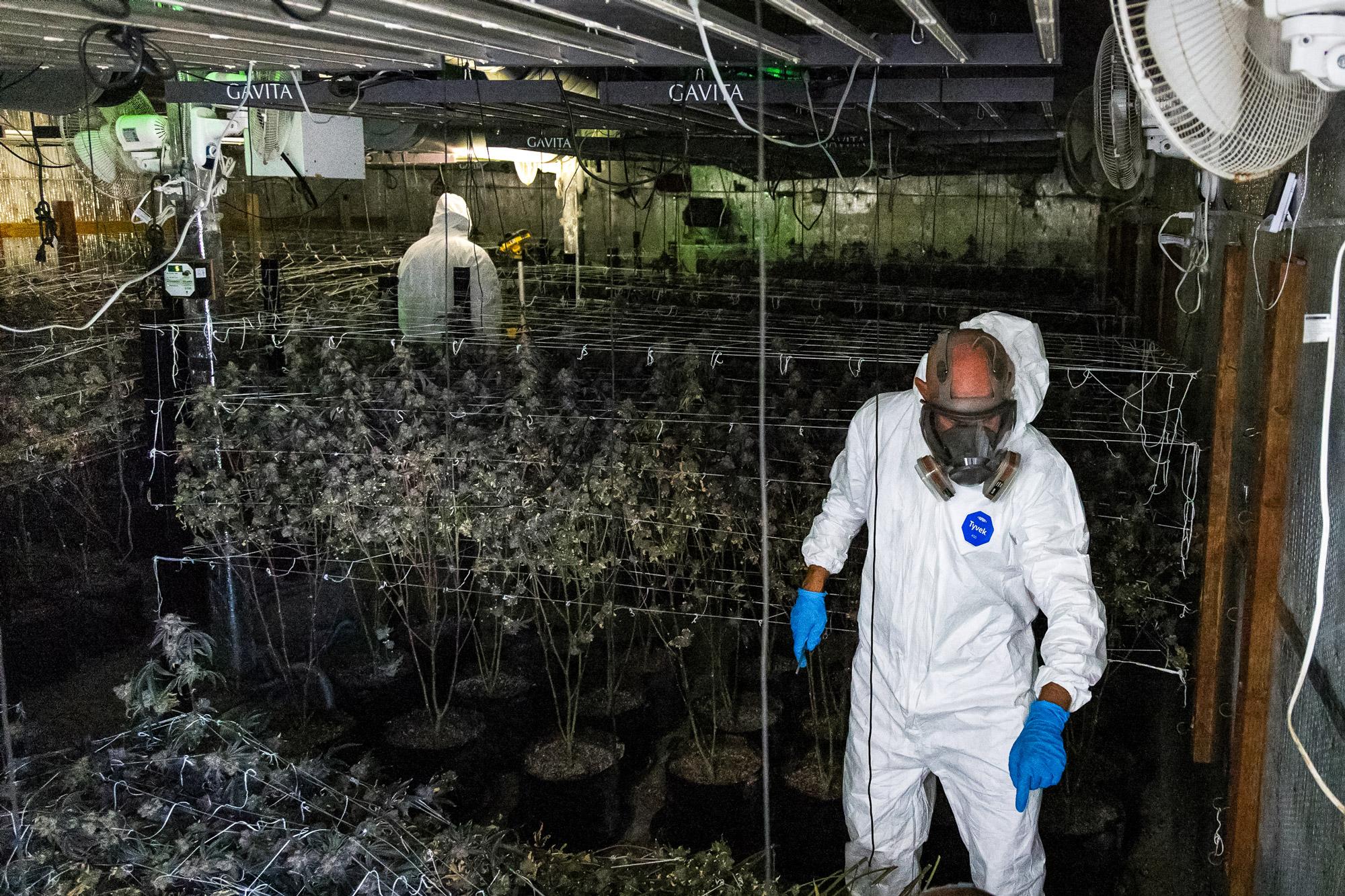
‘It’s Just Pot’
California is home to one of the largest legal cannabis markets in the world. But since legalization, the state’s black market has only grown, dwarfing and infecting its regulated sales.“The bargain that was given to voters was—we’ll give out licenses, collect taxes to fund government services, and smash the illegal market and the criminal organizations would go away,” Katz said. “That’s not happening. And these collateral issues are something they hadn’t even thought about.”
But some say soft laws, a patchwork approach, and regulatory blind spots—as well as a lack of interest from federal authorities and local prosecutors—are allowing the black market to wreak havoc.
Tom Lackey, a California Assemblymember whose district includes the Antelope Valley, said he thinks the dangers are underestimated, in part because of a prevailing misconception that “it’s just pot.”

He pointed to the fact that black market marijuana accounts for some 80 percent of total sales in California, and licensed growers pressured by high taxes and the cost of compliance are taking shortcuts to survive. Various industry analyses over the past several years have estimated that between half and two-thirds of California sales are from illegal sources. According to a 2023 report by New Frontier Data, an estimated $77 billion—or 72 percent of all U.S. sales in 2022—were from illicit sources.
“We’ve overdone it. It’s well-intentioned, but we’ve done very little to go after these illicit players,“ Lackey said. ”The majority of our focus is directed toward those trying to comply, which is ironic.”
When the state does go after illicit players, it’s costly and time-consuming, and labor-intensive intelligence gathering and warrants can lead to dead ends.
During the recent Lancaster raid, the city’s new assistant chief of police, Chris Roberts, gestured at the two dozen highly trained agents in tactical gear and said: “There’s a lot that goes into this. This isn’t cheap.”
Since voters passed Proposition 64 in 2016, illegal cultivation is a misdemeanor. Violating the six-plant-per-person limit carries the same penalty regardless of how many plants you have. And while the law is written to include jail time for certain cultivation, possession, and other crimes, most communities have neither the appetite nor the space to incarcerate people for marijuana offenses.
“The court system would not, in my opinion, be locking someone up for six months,” LaRue said, referring to the penalty for cultivating more than six plants.

“The jails are so impacted in most communities, there is just no space for people committing misdemeanors. To be housed in jail for any substantive time, it needs to be serious or violent. And marijuana possession, even if it’s thousands of plants, is still a minor crime. It would never happen because it’s not viewed as serious enough.”
But that’s less likely to happen in the residential raids that tend to result in misdemeanor referrals to the district attorney, those familiar with the issue say.
“If they’re not going to charge you for dealing drugs, why would they charge you for environmental crimes? Typically drugs are a higher priority,” Welch said.
He estimated that L.A. County’s illegal marijuana trade is “90 percent unenforced—and that might actually be somewhat forgiving.”
Previously, he told The Epoch Times that also applies even when there are narcotics or guns involved at the locations.
“I’ve seen enough of these cases to know they’re not being filed,” he said.
An inquiry to the L.A. County District Attorney’s Office requesting total referrals for cannabis-related crimes, filings, and rejections was not returned.
Linares said it’s far more common for offenders to get fined or receive informal probation.
“I have not seen any jail sentences for the misdemeanors,” Linares said.
Lackey suggested that the relaxed penalties are, in part, because of a misconception—a “’70s marijuana attitude”—about what the illicit industry really is.
“Everybody thinks people in this business look like Zig-Zag,” he said. “No—these are white-collar, brilliant people making billions and billions of dollars. Our system is not taking them seriously.”
The environmental destruction and effects of pesticides are very toxic—everyone knows this, according to Lackey.
“Some of these illicit grows, law enforcement finds deceased animals all over the place,“ he said. ”The residential impact, molds, cancer, fertility issues—all sorts of human threats. But they turn a blind eye because it’s weed.”
Chinese Dominance
At scale, the two problems are inextricably linked.The uneasy mix of crime syndicates running illicit marijuana in California, according to law enforcement officials, includes Chinese and Hmong groups, Mexican cartels and Latin American street gangs, and Chaldean and Armenian organizations.

While Linares says these groups are not all working together, they maintain a kind of territorial detente.
But according to the Drug Enforcement Administration (DEA), Mexican cartels and Chinese groups continue to dominate the state’s black market. In recent years, federal investigations have unearthed how Chinese crime networks have risen to global prominence, in part by laundering cartel drug money.

“Asian drug trafficking organizations have been involved in illegal marijuana cultivation for decades, operating industrial-scale indoor marijuana grows in residential homes, primarily in the western United States,” the report reads.
In 2018, an operation involving hundreds of federal and local agents raided 75 houses in the Sacramento area used for cultivation by Chinese drug traffickers, and it filed civil forfeiture against more than 100 houses, making it one of the largest residential forfeitures in U.S. history.
In its announcement, the Justice Department stated that patterns had begun to emerge during years-long investigations of indoor grows in residential neighborhoods—including financing and distribution methods.

‘It’s All Connected’
“The fentanyl, the money laundering, the marijuana grows—it’s all connected,” Leland Lazarus, associate director of national security at Florida International University’s Jack D. Gordon Institute for Public Policy, told The Epoch Times in an email.These syndicates usually employ illegal Chinese migrants, who are often subjected to forced labor or criminality, terrible working conditions, and even sexual violence, according to Lazarus.
LaRue pointed to an instantly recognizable structure—as if growers had been given a manual—at Chinese-led grows, which dominate Siskiyou County.
“They’re almost cookie-cutter; they all look the same. Even the houses are the same. It’s almost a prescribed thing: This is what you’re going to use, this is what you’re going to have,” the sheriff said. “You can almost go on a site and say, ‘This is Chinese.’”
Lazarus noted that U.S. law enforcement agencies have been tracking “the vast Chinese money laundering networks” across 22 states for years, but the problem remains “a lack of significant resources, language skills, and cultural knowledge to truly dismantle these networks.”
LaRue conducted a recent raid in which his team encountered 28 people onsite—all of them elderly women.
“We couldn’t talk to any of them. One that spoke English, she was not about to let anyone open their mouth. That bothers me,” he said. “What is really going on there?”
The women were released from custody while LaRue’s office continued its investigation.
Some of Lazarus’s recent research has focused on the vast reach of these organizations, far beyond California grow houses or even the East Coast, where federal authorities say they are anchored.
“Like other transnational criminal organizations, Chinese illegal gangs operate around the globe. You’re seeing some of the same illicit activities in Southeast Asia, Europe, and even Latin America,” he said.
Path Forward
In a 2013 memorandum, then-Deputy Attorney General James M. Cole outlined priorities for federal prosecutors in pursuing marijuana-related crimes, in large part deferring to state authority and taking a hands-off approach in jurisdictions that had legalized the drug.
Such guidance relied on an expectation that those jurisdictions “will implement strong and effective regulatory and enforcement systems that will address the threat those state laws could pose to public safety, public health, and other law enforcement interests,” Cole said.
According to many working to contain the collateral fallout of California’s illegal marijuana trade, that has not happened.
“The feds are hands-off on anything involving cannabis,” Katz said, while also pointing to a lack of appetite among local prosecutors. “My guess would be they’re a little gun-shy about jury nullification. ... A jury will be like: ‘Who cares? It’s just cannabis.’”
California needs to take the lead in stronger prosecution efforts and be able to mete out consequences, he said.
“The reason we’re struggling in California is we’ve relaxed consequences, and of course that’s going to increase evasion and it’s going to create victims,” Lackey said. “It really has been a hurtful experience for me to have a front-row seat to watch this mistake being made.”
According to Katz and Morris, the key to navigating the no-man’s land between the state and the feds, between lax prosecution and the absence of a standardized mandate, remains collaboration.
Morris pointed to Riverside’s creation of a roundtable bringing together 43 jurisdictions each quarter to discuss what agents are seeing on the ground.
“We found there were a lot of the same players, especially in our sister counties like San Bernardino. ... There’s a lot of money in this, so they change tactics,” she said.
Katz said his department immerses itself in the issue, cross-training with other disciplines and attending Environmental Protection Agency trainings and medical conferences. In the absence of leadership, or a standard approach, they cobble it together.
“A lot of cities are not investing that kind of effort into combating this problem, so they don’t even know what they don’t know,” he said.
Ultimately, according to Katz, the battle has nothing to do with the morality of cannabis—“that’s not the war we’re waging”—and everything to do with preventing a multibillion-dollar criminal industry from harming and killing residents.
“They don’t care if the pesticides they apply in the house poisons a family,“ he said. ”They don’t care about the people who consume their contaminated cannabis. Money is all that matters to them.
“Only a sociopath would allow other human beings into buildings that might kill them. That’s what we’re combating.”
